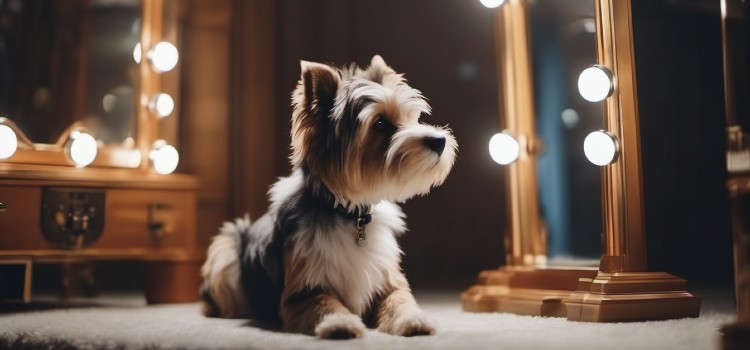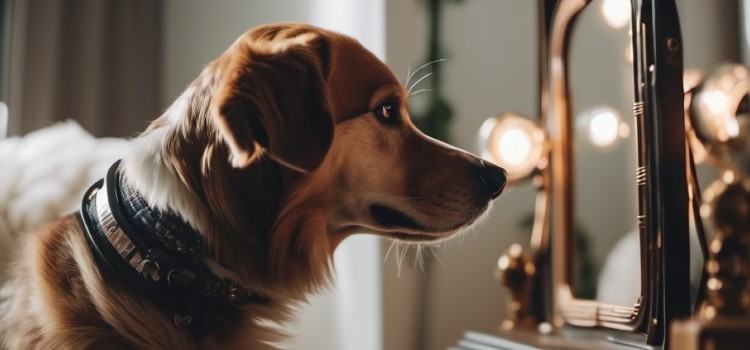As an Amazon Associate committed to the mission of improving the lives of our readers, Live-Clear.com receives a small commission from eligible purchases made through our affiliate links. This revenue enables us to keep producing insightful articles and other material.
Dogs stare in the mirror out of curiosity or confusion about the reflection. It’s a natural behavior that can be entertaining.
Many dog owners have observed their pets staring at themselves in the mirror. While it might seem amusing, this behavior is often a result of curiosity or confusion. Dogs may not recognize themselves in the reflection, leading to a puzzled reaction.

On the other hand, some dogs may be intrigued by their image, much like they would be with any unfamiliar object. Understanding why dogs exhibit this behavior can help owners ensure their pets are comfortable and happy. It’s essential to recognize that staring at the mirror is an expected behavior and does not necessarily indicate any distress or psychological issue in the pet.
Understanding Dog Behavior When Stare In The Mirror
The Curious Case: Dog Behavior
Have you ever caught your canine companion staring intently at themselves in the mirror? The behavior can be fascinating and even a bit perplexing for dog owners. To gain insight into this seemingly odd habit, it’s essential to delve into canine behavior and understand the reasons behind such actions.
The Psychology Behind Dog Stare In The Mirror
Dogs perceive and interpret the world around them differently from humans, and their interactions with mirrors are no exception. Here are some reasons for this behavior:
- Dogs lack self-awareness: The concept of self-recognition in mirrors is a cognitive ability that not all animals possess. Dogs typically do not realize that the reflection they see is their own, often interpreting it as another dog or a different animal.
- Curiosity and playfulness: Dogs are naturally curious and playful creatures. When they see a reflected image, they may be intrigued and want to investigate or engage with the “other” dog they see.
- Social behavior: Dogs are social animals, and they often use visual cues, including body language and facial expressions, to communicate with other dogs. When staring at their reflection, they might be trying to engage in social interaction or assess the body language of the “other” dog.
This mirror-staring behavior is usually harmless, but if it becomes obsessive or causes distress to your pet, it’s best to consult a professional veterinarian or animal behaviorist.
How To Respond As A Dog Owner
As a responsible dog owner, observing your pet’s behavior and ensuring their well-being is crucial. When you notice your dog staring at the mirror, here’s what you can do:
- Provide mental stimulation: Engage your dog in physical and mental activities to redirect their attention and energy away from mirror-staring behavior. Interactive toys and regular exercise can help keep them occupied.
- Positive reinforcement: Reward your dog when they show calm or non-obsessive behavior around mirrors. Using treats or praise can reinforce positive actions and discourage excessive mirror-staring.
- Environmental adjustments: If mirror-staring becomes a persistent issue, consider covering or relocating the mirrors in your home to minimize your dog’s exposure to their reflection.
Understanding and addressing this behavior can ensure a harmonious and fulfilling bond with your beloved pet.
Assessing The Canine Mirror-interaction Behavior
When understanding our furry friends’ behavior, assessing their interaction with mirrors can provide intriguing insights into their thoughts and emotions. Dogs staring into mirrors may display a range of behavioral patterns that warrant our attention. Let’s delve into the observation of these behavior patterns to gain a deeper understanding of why dogs engage with their reflections.
Observing Behavior Patterns
Dogs may exhibit various behaviors when faced with their reflections. Some may show signs of confusion or curiosity, while others might respond with aggression or playfulness. By observing these behavior patterns closely, pet owners and professionals can gain valuable clues about a dog’s emotional state and cognitive responses.
One typical behavior pattern observed in dogs is the tilt of the head or pawing at the mirror, indicating a sense of curiosity or confusion. Conversely, some dogs may display signs of territorial behavior or even fear, which can be reflected in their body language and vocalizations. Recognizing and analyzing these behavior patterns is essential in understanding the underlying motives for their mirror interaction.
Understanding Emotional Triggers
In addition to behavior patterns, it’s crucial to delve into the emotional triggers that prompt dogs to stare into the mirror. Dogs may experience various emotions, including curiosity, anxiety, or even the need for social interaction, which can drive them to engage with their reflections. Understanding these emotional triggers helps pet owners tailor their approach to supporting their canine companions through this unique behavior.
Moreover, dogs that lack social interaction or mental stimulation may seek companionship through mirror interaction, highlighting the importance of enrichment and companionship in their daily lives. By recognizing and addressing these emotional triggers, pet owners can create a more supportive and enriching environment for their beloved pets.

Recognition Or Misunderstanding?
Dogs have long been known for their curiosity, and the peculiar behavior of staring at themselves in the mirror has puzzled pet owners for generations. Some believe this behavior indicates self-recognition, while others attribute it to confusion or misunderstanding. Let’s delve into the fascinating world of dog behavior and explore whether they recognize themselves in the mirror or are simply misunderstanding the reflective image.
Mirror-test Experiments
The mirror test, also known as the “mark test,” is a method used to determine animal self-awareness. In this experiment, a mark, typically a colored dot, is discreetly placed on an animal in a location that can only be seen with a mirror. Suppose the animal realizes the mark is on its own body and attempts to investigate or remove it after seeing the reflection in the mirror. In that case, it is considered to have passed the test, demonstrating self-recognition.
While some species, such as great apes, dolphins, and elephants, have shown the ability to pass the mirror test, dogs have often exhibited different reactions when confronted with their reflection, leading to whether their behavior stems from recognition or misunderstanding.
The Canine Mind And Self-recognition
Dogs have long been known for their inquisitive nature, often displaying curious behavior, including staring at their reflections in the mirror. This behavior might prompt pet owners to wonder about the intricate workings of the canine mind and the concept of self-recognition in dogs.
Cognitive Processing In Dogs
Canines, renowned for their social nature and keen observation skills, possess impressive cognitive processing. This cognitive ability enables dogs to recognize familiar scents, remember routes, and respond to visual and auditory cues. When faced with the image of themselves in a mirror, dogs may exhibit behaviors like pawing at the glass, barking, or even appearing to engage in a form of “play” with their mirror reflection. These actions indicate a level of cognitive processing, which raises intriguing questions about the depth of a dog’s self-awareness.
While self-recognition in dogs remains a topic of ongoing research and debate, the intriguing behaviors displayed in front of mirrors suggest a level of self-awareness. The ability to perceive oneself within the reflection indicates a level of consciousness, even if it differs from how humans understand self-recognition. Researchers continue to explore the complexities of the canine mind, shedding light on the unique awareness and perception that dogs possess.
Canine Emotional Responses To Mirror Encounters
When your dog stares in the mirror, it may react to its reflection. When encountering their reflection, dogs might exhibit various emotions, including curiosity, playfulness, or confusion. This behavior can provide insight into a dog’s self-awareness and social behaviors.
Identifying Emotional Cues
Dogs displaying behaviors such as staring in the mirror can exhibit various emotional cues that provide insight into their mind. Dog owners need to observe their pets closely in such situations to identify possible emotional responses.
Understanding Behavioral Patterns
A dog staring in the mirror may exhibit a range of behaviors, including curiosity, confusion, or even aggression. Owners should observe these patterns to comprehend their pet’s emotional response accurately.
Addressing Emotional Needs
Recognizing and understanding a dog’s emotional responses to mirror encounters can aid in addressing their psychological well-being. Providing appropriate support and interaction is crucial to ensure the dog feels safe and emotionally secure.
Communication And Social Implications
Extensions Of Canine Interaction
Dogs naturally observe their surroundings and interact with those around them. When a dog gazes into a mirror, it often perceives the reflection as another dog. This behavior can be seen as an extension of their innate social instincts. Canine communication involves a variety of visual signals, including eye contact, body postures, and facial expressions. A dog staring at its reflection might attempt to initiate or interpret this visual communication.
Ensuring Social Bonds
In the wild, dogs rely on social bonds with their pack for survival and thriving. When a dog stares in the mirror, it may seek reassurance and social connection, especially if it is anxious or uncertain. This behavior can be a way for dogs to establish a sense of security and belonging within their environment. Moreover, by observing their conduct, dogs may enhance their social understanding and response to human cues.

Addressing Distress In Dog Stare In The Mirror
Signs Of Discomfort
When dogs stare at themselves in the mirror, it can sometimes be a source of distress. Pet owners must recognize the signs of discomfort in their dogs. Some common signs may include:
- Excessive barking or whining while looking at the mirror.
- Pawing at the mirror or attempting to interact with their reflection.
- Aggressive behavior, such as growling or showing teeth.
- Appearing tense or avoiding eye contact with the reflection.
Sources Of Distress
Understanding the potential reasons behind mirror-related distress in dogs can help address the issue effectively. Dogs may react negatively to their reflection due to:
- Uncertainty or confusion about the unfamiliar visual stimuli.
- Perceiving their reflection as a threat or intruder.
- Possible lack of socialization or exposure to mirrors during their formative years.
Pet owners must provide a supportive and reassuring environment for their dogs when encountering mirrors to alleviate distress or anxiety.
Training And Behavioral Interventions For Dog Stare in the Mirror
Addressing your dog’s habit of staring in the mirror may require implementing training and behavioral interventions. By using positive reinforcement techniques and specific strategies, you can help your dog overcome this behavior.
Positive Reinforcement Techniques
Positive reinforcement is a crucial aspect of training dogs. When your dog exhibits desirable behavior, such as ignoring their reflection in the mirror, rewarding them with treats or praise can reinforce this behavior. Use a clicker or verbal cue to mark when your dog turns away from the mirror. Over time, your dog will associate this action with a positive outcome, decreasing mirror-staring behavior.
Behavior Modification
Behavior modification techniques may also redirect your dog’s attention away from the mirror. Environmental enrichment can provide mental stimulation, keeping your dog engaged in alternative activities. Interactive toys or engaging in playtime can redirect your dog’s focus and reduce the allure of the mirror.
When implementing these interventions, it’s essential to be patient and consistent. Understand that each dog responds differently to training and gradual progress should be acknowledged and reinforced. Consultation with a professional dog trainer or behaviorist can provide tailored strategies and support in addressing your dog’s mirror-staring behavior.
Nurturing Healthy Canine Self-awareness On Stare in the Mirror
Dogs displaying an interest in their reflection is an expected behavior. Understanding how to encourage positive mirror encounters to promote healthy self-awareness in our furry friends is essential. When addressing this behavior, we must ensure that our canine companions build a positive relationship with their reflection, promoting their cognitive and emotional well-being.
Encouraging Positive Mirror Encounters
When introducing your dog to a mirror, allow them to approach it at their own pace. Use positive reinforcement such as treats or toys to associate the mirror with pleasant experiences. Gradually, your dog will learn that their reflection is not a threat but a neutral or positive entity.
Another way to encourage a positive mirror encounter is to engage your dog in playful activities in front of the mirror. For example, playing with their favorite toy or engaging in a game of fetch can help them associate the mirror with fun experiences, reinforcing positive feelings towards their reflection.
Creating A Comfortable Environment
Ensure that the area around the mirror is peaceful and familiar to your dog. Positioning: Positioning the mirror in a typical setting, such as their living space, helps reduce any potential stress or anxiety related to the reflection.
Consistency is vital when helping your dog develop positive associations with their reflection. Regularly incorporating the mirror into their daily routine positively and gently can contribute to nurturing healthy self-awareness in dogs.

Conclusion
Your dog staring in the mirror is natural, often out of curiosity. It’s essential to ensure your pet is not fixating on its reflection excessively, as it can indicate anxiety. Understanding this behavior and providing proper stimulation can help your furry friend feel at ease. One way to stimulate your dog is by engaging in interactive playtime or providing puzzle toys that can keep them mentally and physically encouraged. Additionally, ensuring that your dog receives regular exercise and socialization with other dogs can help alleviate any potential anxiety. By addressing their needs and providing a balanced environment, you can help your dog feel more comfortable and reduce excessive fixation on their reflection in the mirror.
Frequently Asked Questions On Why Does My Dog Stare In The Mirror
Dogs may bark, sniff, or seem curious when they see themselves in the mirror. They may interpret their reflection as another dog or a visual curiosity. This behavior varies by individual; some dogs may not be interested.
Yes, dogs are okay with looking at themselves in the mirror. It can be entertaining, and they may recognize themselves. However, some dogs might get confused or agitated by their reflection, so monitoring their reaction is essential.
Dogs may be obsessed with their reflection due to curiosity and social behavior. They view their reflection as another dog and may want to interact. It’s an expected behavior and doesn’t necessarily indicate a problem.
When your dog stares at nothing, it could be a sign of attention, curiosity, or a response to sensory stimuli. It may also indicate they are processing information or experiencing a mild form of hallucination.
Dogs may stare in the mirror out of curiosity or confusion, mistaking their reflection for another dog.
Dog often stare in the mirror out of curiosity, but excessive fixation can indicate anxiety. To help your pet feel at ease, provide proper stimulation through interactive playtime, puzzle toys, regular exercise, and socialization with other dogs. Addressing their needs and providing a balanced environment can help reduce excessive fixation on their reflection. Regular exercise and socialization with other dogs can also alleviate potential anxiety. Understanding and addressing your dog’s needs can create a more comfortable environment for your furry friend.
Amazon and the Amazon logo are trademarks of Amazon.com, Inc, or its affiliates.



